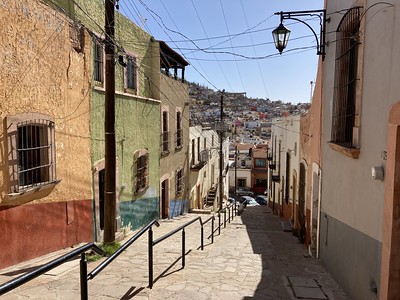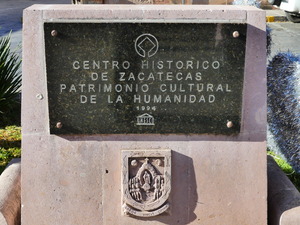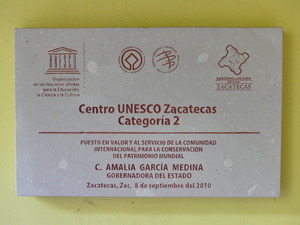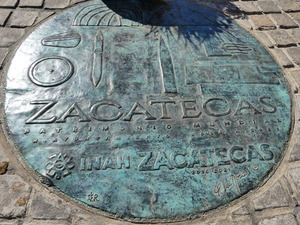Zacatecas

The Historic Centre of Zacatecas comprises a well-preserved Spanish colonial mining town.
Silver was discovered here in the mid-16th century and the city soon became one of the chief mining centres of Mexico. Its original urban design has been preserved, with many of its streets being steep or at different levels due to the mountainous setting. Its notable religious and secular buildings mostly date from the 18th and 19th centuries.
Community Perspective: The pink Cathedral with its Churrigueresque façade is the highlight. You can get good views of the city from the Teleferico to El Eden mine, which can be visited underground as well. Jay’s review has more tips on what to see and do.

Map of Zacatecas
Community Reviews
Clyde

I visited this WHS in January 2022. As my 550th visited WHS, it will always have a special place in my memories, but my experience was further enhanced by meeting up with Zacatecas' director at the UNESCO World Heritage Regional Institute who was directly involved in Zacatecas' nomination and inscription on the WH list and is now mainly managing awareness-raising efforts at schools on UNESCO WHS and collaborating with Caribbean and Latin American states to promote existing WHS and add other tentative ones.
Just like Guanajuato, Zacatecas owes its historic monuments to the wealth generated by its silver and gold mines. It is also situated in a valley but not as narrow as in Guanajuato, and there is the Cerro de la Bufa's cableway which is an easy way to have a panoramic view over the city. For those that are not good with heights, be aware that the ride takes around eight minutes and one of the cablecars has a glass bottom too! From here the main tourist attraction, apart from the view, is the underground train tour inside the El Eden mine and the many bronze statues honoring important figures from the Battle of Zacatecas. Zacatecas is at an altitude of almost 2500 metres so exploring its many churches and sites was slightly more strenuous than other colonial cities and extremely cold in the morning (a bit like in Cusco, Peru).
The city cathedral at the heart of the historic centre is one of the best examples of Mexican Churrigueresque architecture. Its main over-the-top facade (best seen in afternoon light) reminded me a lot of Lecce's cathedral albeit with pink stone. Make sure to also check out its side facade with indigenous elements which is equally full of interesting details. The Plaza de Armas is full of historical buildings but what stood out for me was the Galeria de Nacimientos with cribs from all over the world. Nearby don't miss the Calderon Theatre as well as the second floor of the Mercado Jesús González Ortega. Another massive church not to be missed is the Church of Santo Domingo known locally as the Parish of the Immaculate Conception which would substitute for the cathedral when it was in construction. Its interior with eight Churrigueresque wooden altars gilded with gold mined from the Cerro del Grillo was more interesting than that of the cathedral.
Further on from the Regional Institute of UNESCO World Heritage in Zacatecas, just after the Fuente de los Conquistadores, lies the Rafael Coronel Museum in the former 16th century Convent of St Francis, displaying the largest mask collection in Mexico as well as the UNESCO WHS inscription certificate. Just outside the museum, adjacent to the remaining church facade, is a small square with a black UNESCO WHS plaque. In the courtyard of the UNESCO regional institute there's a Category 2 UNESCO plaque and further down the street near the Fuente de los Faroles there's another UNESCO WHS manhole-like marker sponsored by INAH. A few metres away lies the 18th century El Cubo Aqueduct of Zacatecas with the Plaza de Toros bullring, part of which has now been converted into a hotel (worth viewing mostly after sunset).
Jay T

The Historic Centre of Zacatecas was a delight, and the highlight of my November trip through central Mexico. Zacatecas takes a bit of planning to reach, but it was well worth the six hour detour from the cluster of World Heritage Sites near Querétaro.
Silver mines put Zacatecas on the map, and funded the rich Baroque architecture seen in the stunning cathedral, as well the Temple of Santo Domingo and the Governor's Palace in the Plaza de Armas. Early in its history, the mines also brought missionaries traveling along the Camino Real, such as the Franciscans, who founded the former San Francisco convent (site of one of two World Heritage Site plaques I found in the historic center), and the Augustinians, who founded the Temple of San Agustin. On my one day in Zacatecas, I spent a couple early hours visiting the churches that were open and admiring the architecture, and then strolling the relatively quiet streets (likely because it was Revolution Day, one of Mexico's public holidays). The neo-classical facade of the Calderon theater was beautiful, and the small plazas scattered around the city were a peaceful way to start the day.
I had two sites I definitely wanted to see when I was in Zacatecas. The first was the overlook from La Bufa, the imposing bluff overlooking the city. La Bufa played a significant role in 1914 during the Mexican Revolution, as Pancho Villa successfully wrested the hill from federal troops before taking the city of Zacatecas, and from there marching on to Mexico City. On top of the hill are statues of the revolutionaries, a museum with a good exhibition on the Battle of Zacatecas, and panoramic observation points; I particuarly liked the view past the colonnade next to the central plaza. To reach the summit of La Bufa, I took the Teleférico, an aerial tramway whose cable cars are hard to miss as they transit over the city center.
After I returned from La Bufa via the Teleférico, I exited the station and walked to the nearby entrance of El Eden mine, the other site I was not going to miss in town. El Eden mine was operational for almost four hundred years, from 1586 through 1960, and brought tremendous wealth to the Spanish empire and later to Mexico. The mine offers guided tours from both of its entrances; from the entrance near the Teleferico, the tour starts in an old mine shaft before descending by elevators to the main levels where the tour is conducted. The tour was in Spanish, and gave a very good overview of the significance of the mine and the hard life of the miners, as well as some traditions and superstitions. The tour ends at a mineral museum, from which tour members can take a mine train out of the mine to the lower entrance, located past the hospital at the end of the Alameda Trinidad Garcia de la Cadena park. Tours starting at the lower entrance end by the elevators that take passengers back up to the Teleférico entrance, which can be a convenient way for travelers to avoid the hike uphill to the Teleférico.
The rest of the afternoon I spent exploring the city and finding interesting niches like the Fountain of the Conquistadors and the plaza by the former San Francisco convent. Zacatecas was home to two Mexican artists and brothers, Pedro and Rafael Coronel (the latter was also the son-in-law of Diego Rivera). Both have museums in the city, which I would love to visit at a latter date when I have more time (and when they are open). The Pedro Coronel museum is located near the Temple of Santo Domingo, while the Rafael Coronel museum is located in the former San Francicso convent, and has a well-regarded mask collection.
Taking Solivagant's advice, I walked back through town toward the Sierra de Alica Park to see the Zacatecas Aqueduct and to eat dinner at the restaurant in the Quinta Real hotel, which was built in a former bullring. The food was fantastic, but the sunset and early evening view over the central plaza with the aqueduct in the background was even better. To cap off the day, I walked back to the historic center, where Revolution Day festivities were well under way. I passed a marching band and parade on the main street through town before watching live theater in the plaza below the 19th century González Ortega Market. Vendors were selling snacks and souvenirs everywhere, and the Governor's Palace in the Plaza de Armas was lit up for the festivities; the family atmosphere made for a memorable way to end my day. Zacatecas may not be on most visitor's itineraries when touring Mexico, but I found it a fascinating city with a rich history, well-deserving of World Heritage status.
Incidentally, as a bit of trivia, Zacatecas is home to one of UNESCO's Category 2 World Heritage centers, focusing on heritage in Latin America and the Caribbean.
Logistics: The Historic Center of Zacatecas is very easily navigated on foot, though there are some hills, and the city is at a high altitude. The city can also be reached by bus, by plane, or by private transport.
Griselda Orozco
Zacatecas is beautiful. It feels as if you are in a Europe. Italy maybe? Absolutely wonderful. You can really feel the positive energy in the air. There is something about this city that makes you not want to leave.I think it's because there is a certain intimacy you feel with city.
Solivagant

As a “colonial” centro historico Zacatecas has a number of similarities with Guanajuato – particularly its setting in a deep(ish) valley and its wealth from Silver. We visited it first and were quite impressed – until we saw Guanajauto! Michelin has it about right when it grants Guanajuato *** (worth a journey) and Zacatecas ** (worth a detour).
With a population of about 130000 it is significantly larger then Guanajuato. Its valley is less confined and it has spread more with a surrounding and unattractive suburban area but the centre is pleasant and relaxed – albeit not traffic free. The city lies at an altitude of 8000ft – which you will feel if you do much walking! The cathedral (photo 1) is perhaps the only building which trumps Guanajuato’s offering with its magnificent “pinkish” façade - its floodlit appearance at night is particularly fine (photo 2). Beyond that there is the usual range of “niche” museums (covering, inter alia, Surrealist Art and Indigenous Masks), pleasant gardens, squares, colonial streets, mansions etc. We didn’t take the teleferico which, unlike Guanjuato’s funicular, actually crosses over the city from one side to the other – but then Zacatecas has no viewpoint quite like Pipila. An interesting “non-UNESCO” visit is to the Quinta Real Hotel built around Zacatecas’s bull ring – the (expensive for Mexico but not so much in European terms) restaurant is built into the seating tiers. It is at least worth going into.
Community Rating
- : Alberto Rodriguez Gutierrez Joaofg
- : Feldhase
- : Alexander Lehmann Tamara Ratz Mihai Dascalu Craig Harder Julio Moreno Jay T Ivan Rucek Alejandro Lau
- : GeorgeIng61 Lara Adler Hanming Xiquinho Silva Svein Elias Michael Ayers Martina Rúčková
- : Szucs Tamas Randi Thomsen Shandos Cleaver George Evangelou Argo
- : Solivagant Clyde Wojciech Fedoruk Stanislaw Warwas Jon Opol Els Slots
- : Clem C
- : Zoë Sheng
Site Info
Site History
1993 Inscribed
Site Links
Unesco Website
Official Website
In the News
Connections
The site has 24 connections
Art and Architecture
Constructions
Ecology
History
Human Activity
Religion and Belief
Timeline
Trivia
World Heritage Process
Visitors
98 Community Members have visited.
The Plaque
 (photo by Clyde)
(photo by Clyde) (photo by Clyde)
(photo by Clyde) (photo by Clyde)
(photo by Clyde)